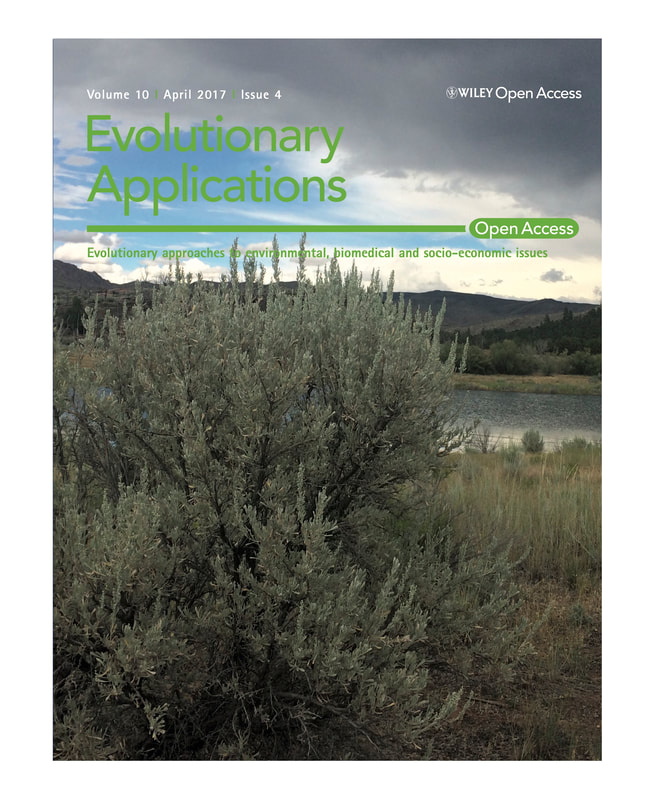Climate drives adaptive genetic responses associated with survival in big sagebrush (Artemisia tridentata)
Chaney, L., Richardson, B. A., & Germino, M. J. (2016). Climate drives adaptive genetic responses associated with survival in big sagebrush (Artemisia tridentata). Evolutionary Applications. DOI: 10.1111/eva.12440; Data: http://dx.doi.org/10.5061/dryad.32s2t; Analysis: https://github.com/lchaney/Sagebrush_Mort
Abstract
|
A genecological approach was used to explore genetic variation for survival in Artemisia tridentata(big sagebrush). Artemisia tridentata is a widespread and foundational shrub species in western North America. This species has become extremely fragmented, to the detriment of dependent wildlife, and efforts to restore it are now a land management priority. Common-garden experiments were established at three sites with seedlings from 55 source-populations. Populations included each of the three predominant subspecies, and cytotype variations. Survival was monitored for 5 years to assess differences in survival between gardens and populations. We found evidence of adaptive genetic variation for survival. Survival within gardens differed by source-population and a substantial proportion of this variation was explained by seed climate of origin. Plants from areas with the coldest winters had the highest levels of survival, while populations from warmer and drier sites had the lowest levels of survival. Survival was lowest, 36%, in the garden that was prone to the lowest minimum temperatures. These results suggest the importance of climatic driven genetic differences and their effect on survival. Understanding how genetic variation is arrayed across the landscape, and its association with climate can greatly enhance the success of restoration and conservation.
You can watch my presentation at the Evolution conference here. |

Artemisia tridentata (big sagebrush) is a widespread and foundational shrub species in western North America that has become extremely fragmented, to the detriment of dependent wildlife, and efforts to restore it are now a land management priority.
https://onlinelibrary.wiley.com/doi/epdf/10.1111/eva.12422
|
Will phenotypic plasticity affecting flowering phenology keep pace with climate change?
Richardson, B. A., Chaney, L., Shaw, N. L., & Still, S. M. (2016). Will phenotypic plasticity affecting flowering phenology keep pace with climate change? Global Change Biology. DOI: doi: 10.1111/gcb.13532; Data and analysis: https://github.com/brichardsonfs/flower
Abstract
Rising temperatures have begun to shift flowering time, but it is unclear whether phenotypic plasticity can accommodate projected temperature change for this century. Evaluating clines in phenological traits and the extent and variation in plasticity can provide key information on assessing risk of maladaptation and developing strategies to mitigate climate change. In this study, flower phenology was examined in 52 populations of big sagebrush (Artemisia tridentata) growing in three common gardens. Flowering date (anthesis) varied 91 days from late July to late November among gardens. Mixed-effects modeling explained 79% of variation in flowering date, of which 46% could be assigned to plasticity and genetic variation in plasticity and 33% to genetics (conditional R2 = 0.79, marginal R2 = 0.33). Two environmental variables that explained the genetic variation were photoperiod and the onset of spring, the Julian date of accumulating degree-days >5 °C reaching 100. The genetic variation was mapped for contemporary and future climates (decades 2060 and 2090), showing flower date change varies considerably across the landscape. Plasticity was estimated to accommodate, on average, a ±13-day change in flowering date. However, the examination of genetic variation in plasticity suggests that the magnitude of plasticity could be affected by variation in the sensitivity to photoperiod and temperature. In a warmer common garden, lower-latitude populations have greater plasticity (+16 days) compared to higher-latitude populations (+10 days). Mapped climatypes of flowering date for contemporary and future climates illustrate the wide breadth of plasticity and large geographic overlap. Our research highlights the importance of integrating information on genetic variation, phenotypic plasticity and climatic niche modeling to evaluate plant responses and elucidate vulnerabilities to climate change.
Climate-based seed transfer of a widespread shrub: population shifts, restoration strategies, and the trailing edge
Richardson, B. A., & Chaney, L. (2018). Climate‐based seed transfer of a widespread shrub: population shifts, restoration strategies, and the trailing edge. Ecological Applications, 28(8), 2165-2174. DOI: 10.1002/eap.1804
Abstract
Genetic resources have to be managed appropriately to mitigate the impact of climate change. For many wildland plants, conservation will require knowledge of the climatic factors affecting intraspecific genetic variation to minimize maladaptation. Knowledge of the interaction between traits and climate can focus management resources on vulnerable populations, provide guidance for seed transfer, and enhance fitness and resilience under changing climates. In this study, traits of big sagebrush (Artemisia tridentata) were examined among common gardens located in different climates. We focus on two subspecies, wyomingensis and tridentata, that occupy the most imperiled warm-dry spectrum of the sagebrush biome. Populations collected across the sagebrush biome were recorded for flower phenology and survival. Mixed-effects models examined each trait to evaluate genetic variation, environmental effects, and adaptive breadth of populations. Climate variables derived from population-source locations were significantly associated with these traits (P < 0.0001), explaining 31% and 11% of the flower phenology and survival variation, respectively. To illustrate our model and assess variability in prediction, we examine fixed and focal point seed transfer approaches to map contemporary and climate model ensemble projections in two different regions of the sagebrush biome. A comparison of seed transfer areas predicts that populations from warmer climates become more prevalent, replacing colder-adapted populations by mid-century. However, these warm-adapted populations are often located along the trailing edge, margins of the species range predicted to be lost due to a contraction of the climatic niche. Management efforts should focus on the collection and conservation of vulnerable populations and prudent seed transfer to colder regions where these populations are projected to occur by mid-century. Our models provide the foundation to develop an empirical, climate-based seed transfer system for current and future restoration of big sagebrush.
